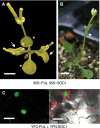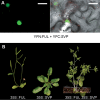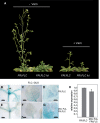Sequential action of FRUITFULL as a modulator of the activity of the floral regulators SVP and SOC1
- PMID: 24465009
- PMCID: PMC3935574
- DOI: 10.1093/jxb/ert482
Sequential action of FRUITFULL as a modulator of the activity of the floral regulators SVP and SOC1
Abstract
The role in flowering time of the MADS-box transcription factor fruitfulL (FUL) has been proposed in many works. FUL has been connected to several flowering pathways as a target of the photoperiod, ambient temperature, and age pathways and it is has been shown to promote flowering in a partially redundant manner with suppressor of overexpression of constans 1 (SOC1). However, the position of FUL in these genetic networks, as well as the functional output of FUL activity during floral transition, remains unclear. In this work, a genetic approach has been undertaken to understand better the functional hierarchies involving FUL and other MADS-box factors with well established roles as floral integrators such as SOC1, short vegetative phase (svp) or flowering locus C (FLC). Our results suggest a prominent role of FUL in promoting reproductive transition when photoinductive signalling is suppressed by short-day conditions or by high levels of FLC expression, as in non-vernalized winter ecotypes. A model is proposed where the sequential formation of FUL-SVP and FUL-SOC1 heterodimers may mediate the vegetative and meristem identity transitions, counteracting the repressive effect of FLC and SVP on flowering.
Keywords: FLC; FUL; Flowering; MADS-box factors.; SOC1; SVP.
Figures





Similar articles
-
Floral regulators FLC and SOC1 directly regulate expression of the B3-type transcription factor TARGET OF FLC AND SVP 1 at the Arabidopsis shoot apex via antagonistic chromatin modifications.PLoS Genet. 2019 Apr 4;15(4):e1008065. doi: 10.1371/journal.pgen.1008065. eCollection 2019 Apr. PLoS Genet. 2019. PMID: 30946745 Free PMC article.
-
Genetic and spatial interactions between FT, TSF and SVP during the early stages of floral induction in Arabidopsis.Plant J. 2009 Nov;60(4):614-25. doi: 10.1111/j.1365-313X.2009.03986.x. Epub 2009 Jul 25. Plant J. 2009. PMID: 19656342
-
AGL24 acts in concert with SOC1 and FUL during Arabidopsis floral transition.Plant Signal Behav. 2012 Oct 1;7(10):1251-4. doi: 10.4161/psb.21552. Epub 2012 Aug 20. Plant Signal Behav. 2012. PMID: 22902690 Free PMC article.
-
Regulation and function of SOC1, a flowering pathway integrator.J Exp Bot. 2010 May;61(9):2247-54. doi: 10.1093/jxb/erq098. Epub 2010 Apr 22. J Exp Bot. 2010. PMID: 20413527 Review.
-
Make hay when the sun shines: the role of MADS-box genes in temperature-dependant seasonal flowering responses.Plant Sci. 2011 Mar;180(3):447-53. doi: 10.1016/j.plantsci.2010.12.001. Epub 2010 Dec 14. Plant Sci. 2011. PMID: 21421391 Review.
Cited by
-
Genome-Wide Identification and Expression Analysis of the SQUAMOSA Promoter-Binding Protein-like (SPL) Transcription Factor Family in Catalpabungei.Int J Mol Sci. 2023 Dec 20;25(1):97. doi: 10.3390/ijms25010097. Int J Mol Sci. 2023. PMID: 38203267 Free PMC article.
-
A Viral Suppressor of RNA Silencing May Be Targeting a Plant Defence Pathway Involving Fibrillarin.Plants (Basel). 2022 Jul 22;11(15):1903. doi: 10.3390/plants11151903. Plants (Basel). 2022. PMID: 35893605 Free PMC article.
-
Genetic control of meristem arrest and life span in Arabidopsis by a FRUITFULL-APETALA2 pathway.Nat Commun. 2018 Feb 8;9(1):565. doi: 10.1038/s41467-018-03067-5. Nat Commun. 2018. PMID: 29422669 Free PMC article.
-
Quantitative Proteomics Analysis of Lettuce (Lactuca sativa L.) Reveals Molecular Basis-Associated Auxin and Photosynthesis with Bolting Induced by High Temperature.Int J Mol Sci. 2018 Sep 28;19(10):2967. doi: 10.3390/ijms19102967. Int J Mol Sci. 2018. PMID: 30274198 Free PMC article.
-
LsMYB15 Regulates Bolting in Leaf Lettuce (Lactuca sativa L.) Under High-Temperature Stress.Front Plant Sci. 2022 Jun 28;13:921021. doi: 10.3389/fpls.2022.921021. eCollection 2022. Front Plant Sci. 2022. PMID: 35837450 Free PMC article.
References
-
- Amasino R. 2010. Seasonal and developmental timing of flowering. The Plant Journal 61, 1001–1013 - PubMed
-
- Araki T. 2001. Transition from vegetative to reproductive phase. Current Opinion in Plant Biology 4, 63–68 - PubMed
-
- Blázquez MA, Soowal L, Lee I, Weigel D. 1997. LEAFY expression and flower initiation in Arabidopsis . Development 124, 3835–3844 - PubMed
-
- Borner R, Kampmann G, Chandler J, Gleissner R, Wisman E, Apel K, Melzer S. 2000. A MADS domain gene involved in the transition to flowering in Arabidopsis. The Plant Journal 24, 591–599 - PubMed
Publication types
MeSH terms
Substances
LinkOut - more resources
Full Text Sources
Other Literature Sources
Molecular Biology Databases

